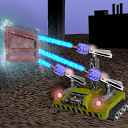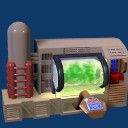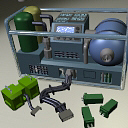|
|
 Vehicular Systems
Vehicular Systems
Conveyance
| Wheels |
Wheels
have been a staple method
of providing mobility to a vehicle since the dawn of
intelligent life. A direct, flexible, cheap, low-power
methodology with numerous inherent failsafes. Common
configurations include two-wheeled and four-wheeled
vehicles. More wheels can be added in-line or
side-by-side to help distribute weight or provide more
drive-wheel contact with uneven terrains. Wheels can be
solid to prevent puncture or, commonly on civilian
vehicles, filled with atmospheric gas, inert
gasses like nitrogen, or semi-solid polymers to provide a less bumpy ride. |
| Tracks |
 |
Metal or polymer
belts driven by wheels. Tracks provide a long,
wide frictional surface that help guarantee grip
on irregular surfaces and help distribute the
weight of heavy vehicles
over a wide area. Tracks are generally paired
side-by-side and can be used in in-line pairs to
distribute the weight of particularly large
vehicles. |
|
| Fixed wing |
Wings are
curved surfaces that provide lift when they are pushed
through the air. Fixed wing craft will have, typically,
one wing on either side of a fuselage or an entire fuselage
shaped to act as a wing. As the craft is pushed
forward by some means of propulsion. The wing has the
advantage of providing cheap, unpowered lift so long as
the vehicle is moving forward. |
| Rotary Wing |
Wings are
curved surfaces that provide lift when they are pushed
through the air. Rotary wing craft spin a set of wings
in order to pull a vehicle directly up
into the air. While fixed wing aircraft require forward
motion to differentiate themselves from the common
stone, rotary wing vehicles are capable of
hovering. |
| ACV |
 |
Air
Cushion Vehicles propel air downward and capture
it in a skirt that hangs between the vehicle frame
and the ground. This forms a pad of air which the
vehicle floats upon. The ACV is generally very
maneuverable
and good for a variety terrains from rough to
liquid, since the vehicle itself is never in
direct physical contact. |
|
| Legged |
Emulative of
living things, mechanically legged vehicles can be more
adaptive and sensitive to the surrounding terrain, based
on the complexity of their control circuits. Two or more
legs can be used to provide for design criteria from
load spread to minimal footprint to stability. |
Power
|
Fusion Reactors |
Nuclei of atoms
are fused together in an endothermic reaction. The energy of
the fusion reaction is harvested by a Conciptum Trajector
Field, which converts the heat and molecular kinetics from the
reaction into DC electricity.
Fusion reactors are a traditional and well-developed source of energy
and fairly common power sources on relatively large vehicles. The
are safe, simple, and efficient. Fuel is easily attained and small
amounts are capable of producing large amounts of energy. |
|
Antimatter Reactors |
 |
Antimatter is released to react
with matter. Big energy results in the form of high-energy gamma
rays which are harvested into electricity through the use of tuned
Conciptum Trajector Fields.
While the fuel and the reactor are
themselves relatively small, the support and safety equipment
required make these practical for only large vehicles.
|
|
Batteries |
 |
By using chemicals with differing electric
properties, energy generated by another source can be
stored for gradual use at a later time. Batteries are extremely
compact and can provide the energy to run smaller vehicles for
extended periods of time without consuming the large amounts of
chassis space taken by reactors. |
|
Fuel cell |
 |
Fundamentally, fuel cells combine hydrogen and oxygen into water and
electricity. Some cells may use hydrogen-rich solids or other
chemicals for convenience or effect but the fundamental reaction is the same.
The reaction can be almost instantaneously reversed by adding energy back into the
system, making the fuel cell act as a rechargeable battery. Fuel
cells scale well from tiny to huge and are an efficient, compact
source of primary or backup power on a wide variety of vehicles. |
Propulsion
| Grav Drive |
Grav drives are smaller
versions of the grav drives that power starships. Pattonetti
Emitters create highly focused and shaped gravitational fields that
are used to push against control surfaces and precisely maneuver
vehicles. They are large, complex systems that require complicated electronics and
control systems and a finely tuned gravity generator. They are very expensive
and require constant maintenance but provide exception control and
maneuverability to very large vehicles. |
| Grav Ram |
The G-ram is a very crude
version of the grav drive, scaled for simplicity, affordability,
and size.
Simple, pre-tuned Pattonetti emitters create gravity fields at a single focal point.
Adjustable amplitude allows variable pushes and pulls in a single
direction only, so a single generator will provide lift or motion
in a single direction only. The size, power, maintenance, electronics,
and control systems are greatly reduced over a full-blown grav
drive allowing their use in relatively smaller, cheaper vehicles. |
| Direct Drive Motor |
Electric motors are
highly efficient, powerful, and capable of being controlled with
extreme precision through very simple support circuits. Motors are
used to move frictional drive surfaces like wheels, tracks, or
legs. |
| Jet |
Air is compressed,
mixed with a fuel source, and ignited to provide a high-speed
stream which is used for propulsion. Jets are generally used for
high speed, flight-based vehicles. |
| Propeller |
Propellers are
basically spinning wings whose lift is used to provide motive force
for a vehicle. Propellers can be used to initiate motion in rotary
or fixed wing craft or can
be used to create the air cushion for an ACV. |
| Super-jet |
The superjet uses the
same principals as a standard jet engine, substituting the heat of
a fusion reaction for an ignited fuel source. Compressed air is
super-heated by a nuclear
fusion reaction and super-expanding gasses generate enormous thrust
in relatively small vehicles. |
Other Vehicular Systems
|
Communications and navigation |
|
|
Computers |
|
|
AI or remote driver/gunner/navigator |
|
|
Repair and safety systems |
Droid, nano, mechanical |
|